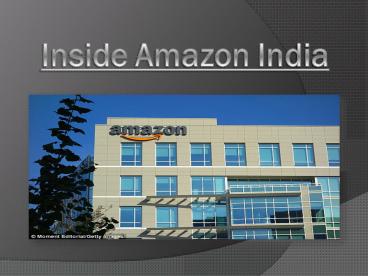Inside Amazon India - PowerPoint PPT Presentation
Title:
Inside Amazon India
Description:
The Seattle based e-commerce company which was founded in 1994 came in India in 2013. They registered the domain name Amazon.in on June 5th 2013. The global E-comm leader entered our market when homegrown players like Flipkart & Snapdeal had already set up shop. Most pundits said that Amazon would have to start from scratch however; Amazon has fared well by effectively using the cards they had been dealt with. Let’s check out some actions which helped Amazon in its journey in India to surpass the local competition. – PowerPoint PPT presentation
Number of Views:35
Title: Inside Amazon India
1
Inside Amazon India
2
The Seattle based e-commerce company which was
founded in 1994 came in India in 2013.
The global E-comm leader entered our market when
homegrown players like Flipkart Snapdeal had
already set up shop. Most pundits said that
Amazon would have to start from scratch however
Amazon has fared well by effectively using the
cards they had been dealt with. Lets check out
some actions which helped Amazon in its journey
in India to surpass the local competition.
3
The Base Was Set
- Before Amazons arrival, the E-commerce market
was estimated to be around 5-6 Billion dollars,
including travel bookings and online shopping.
Companies like Flipkart, Myntra so on created a
niche for themselves with their amazing ad
campaigns, and geared the Indian consumer to shop
online. Amazon poured in heavy investment to its
advantage. They targeted tier 2 3 cities as
the metro cities were already aware of the
benefits of online shopping. Amazon put efforts
in building a brand name and educating sellers
before starting its operations.
4
Worn Competition Out
By the time amazon entered the Indian market, the
local players has a good few years run. They were
ahead in the game, but also burnt a lot of cash
in customer acquisition through discounts
marketing. Most of the smaller ecommerce
companies were either acquired or shut down shop.
Industry leader Flipkart which successfully
managed to get funding, was forced to keep
burning cash to keep the discounts running. The
amount of losses was more or less affecting the
profit gained from the sales. Companies like
Snapdeal had to lay off lots of employees. The
major target for home players revolves around
getting more funding and keeping the burn rate to
a minimum.
5
Third party market place
The laws in India made Amazon work with sellers
in India and provide them a platform to conduct
business. Amazon couldnt sell directly to
customers like they does in the USA.
They revamped their entire ecosystem to work in
conjunction with the millions of small sellers.
Instead of posing as a threat, they gave them a
business opportunity. Amazon recruited a vast
number of suppliers and educated them to sell on
Amazon India. They helped the sellers in creating
a catalogue of their products. They then acted as
a third party market place with solid logistics
to lower running costs. Currently all major
ecommerce players like Flipkart Jabong use the
marketplace model, where they connect sellers
with buyers. A third party marketplace model
lowers costs efficiently than direct selling.
6
Understanding The Indian Shopper
Shopping online in India with cash-on-delivery
(COD) is preferred by over 50 of shoppers. Most
Indian Consumers are still comfortable with COD
rather than paying online.
- Home Grown E-commerce players have therefore
Relied on tactics like COD payments, liberal
return policies, free or subsidized shipping and
in-house logistics and more importantly vast
discounts. For a company like Amazon with over 50
billion dollars in revenue, letting the Indian
E-comm players burn their resources in
advertising and promotion and exclusive discounts
would have been the safest bet. But nonetheless
they were confident about entering the huge
Indian market and incorporated some of the
tactics used by Indian players.
7
Flipkarts big billions day and Amazons Great
Indian Festival went toe to toe recently. With
Flipkart Crossing the Rs. 1000 Crore mark in its
first day of the sale. The amount of discounts
given to the consumers would have definitely
resulted in a sales fatigue. Amazon with their
deeper pockets normally offers more than the
competition in the form of Amazon Cashback on
payments made through Amazon Pay. Amazon has been
a pioneer in affiliate marketing. They have
partnered with websites like xerve.in
Cashkaro.com and many more to boost sale.
Shopping on these partner websites further gives
additional cashback and helps shoppers save money
on their spending.
8
The more offerings and better service a website
has, the better the loyalty. Amazon has created a
niche for itself in a short time with some
amazing customer service and great catalogue of
products. Currently the Indian market is big
enough to accommodate multiple players. A few
more years will tell us who would be crowned the
ultimate king of the online marketplace in India.






















![Dr. Vishwanath Karad MIT World Peace University – [MIT WPU], Pune PowerPoint PPT Presentation](https://s3.amazonaws.com/images.powershow.com/9671554.th0.jpg?_=20211013033)








